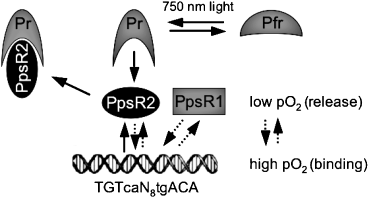R-BphP
From 2009.igem.org
(→To find) |
(→To find) |
||
| Line 19: | Line 19: | ||
<br> - Sequences of the genes involved in the pathway (minimal genes to => [http://www.ncbi.nlm.nih.gov/ Pubmed]) | <br> - Sequences of the genes involved in the pathway (minimal genes to => [http://www.ncbi.nlm.nih.gov/ Pubmed]) | ||
<br>[[Media: ORS278_BrBphP_genomic_seq.txt|ORS278 BrBphP genomic sequence]] | <br>[[Media: ORS278_BrBphP_genomic_seq.txt|ORS278 BrBphP genomic sequence]] | ||
| + | <br>[[Media: ORS278_PpsR1_genomic_seq.txt|ORS278 PpsR1 genomic sequence]] | ||
| + | <br>[[Media: ORS278_PpsR2_genomic_seq.txt|ORS278 PpsR2 genomic sequence]] | ||
==Implementation== | ==Implementation== | ||
Revision as of 14:58, 9 June 2009
Contents |
The BphP / PpsR system
PpsR1 is a redox sensitive activator. It binds DNA under anaerobic conditions, and forms a tetramer via a disulfide bond. This interaction is ablated in the mutant PpsR1-C429S; meaning that we should be able to mimic an anaerobic system even under aerobic conditions.
PpsR2 is a transcriptional repressor, regulated by BphP.
PpsR1 and PpsR2 bind to TGTN_12ACA possibly arranged in tandem with a 7 base spacer. The affinity for both PpsRs are around 100nM.
BphP (or BrBphP for the Bradyrhizobium variant) is sensitive to far-red light (~770nm) and controls PpsR1.
For more info, see [1].
Similar constituents could possibly be derived from R. Palustris as well with the following model derived from [2]:

To find
- Define genetic circuit Tú
- Look for exact wavelength for the corresponding light receptor Basile
- Sequences of the genes involved in the pathway (minimal genes to => Pubmed)
ORS278 BrBphP genomic sequence
ORS278 PpsR1 genomic sequence
ORS278 PpsR2 genomic sequence
Implementation
There are two modes in which we can use the system. The minimal complement requires PpsR2 and its regulator BphP. We can generate a hybrid system that uses a well known activator or transcription or a constitutively active promoter which will be repressed via PpsR2 upon exposure to far-red light (770nm).
It is also possible to reconstitute the entire system including PpsR1-C429S, which will serve as the activator and will be de-coupled from the oxidative state of the cell due to the ablation of the disulfide bond formation.
To do
- contact Eric Giraud (giraud@mpl.ird.fr) and ask if he could send us the following material:
- Bradyrhizobium ORS278
- The following plasmids:
- pBAD::ppsR1
- pBAD::ppsR2
- pGEM-T::ppsR2/BrbphP
- the PpsR1-C429S construct
Found
- Bacterium: Bradyrhizobium can be ordered on ATCC
| Home | The Team | The Project | Parts Submitted to the Registry | Modeling | Notebook | Lectures | Team Management | References |
|---|
 "
"